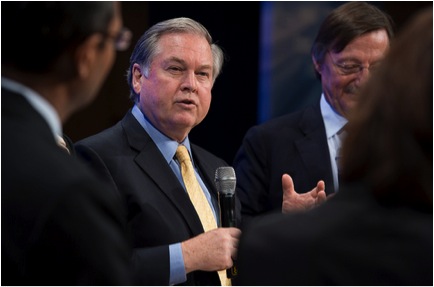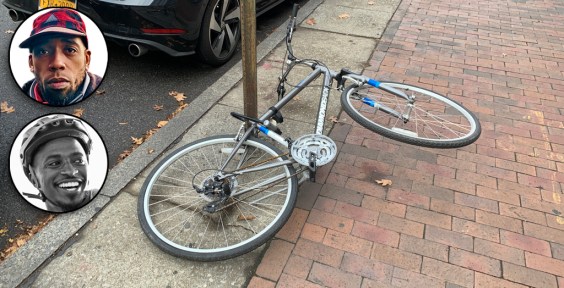Bike and pedestrian funding got slashed. Federal assistance for transit operations was rejected. Even the performance measures – arguably the high point of the recently passed federal transportation bill – are too weak to be very meaningful. For Americans who want federal policy to support safe streets, sustainable transportation, and livable neighborhoods, there were few bright spots in the transportation bill Congress passed last month.

But state transportation departments are celebrating. They scored victory after victory, getting a bigger share of federal funding with fewer rules and regulations attached.
In the Senate, advocates were able to work some reforms into the bill and mobilize grassroots support for amendments like the Cardin-Cochran provision, which put funds for street safety projects in the hands of local governments, not state DOTs. But the House never managed to pass a bill of its own, and the opaque conference committee process was an exercise in horse-trading that advocates found difficult to penetrate.
The final product, which included measures like raising the federal contribution for certain highway expansions, seemed finely tailored to benefit DOTs in several ways. "This is a bill written by and for the benefit of state DOTs at the expense of both federal oversight and regional and community outcomes," wrote David Burwell, director of the climate change program of the Carnegie Endowment for International Peace, in an email shortly after the bill passed. He said the policy changes "are too elegantly crafted and specific in their effect to have been written, or even conceived, by members of Congress or their staff."
For state DOTs, access to lawmakers is a given. "We worked very closely with the House and Senate to craft those measures," AASHTO Director John Horsley confirmed to Streetsblog in an interview yesterday. He said that while AASHTO offered recommendations, no text written by AASHTO made it into the bill verbatim, as far as he knows.
According to Horsley’s account, AASHTO followed a pretty standard script when it came to advocating for their interests on the Hill. Every stakeholder and special interest under the sun had its lobbyists knocking on lawmakers’ doors, offering their two cents – everyone from gravel producers to equipment manufacturers to environmentalists to free market fundamentalists. It’s just that the state DOTs seemed to get everything on their wish list.
Horsley said AASHTO had been laying the groundwork for many, many months before conference started, working with Republican House Transportation Committee staffers as well as aides of both parties in the Senate. (He didn’t mention working with House Democrats, who were shut out of the process from day one.)
The House is where the magic happened for AASHTO. “We’ve been very pleased with where the Senate bill started,” Horsley said. “And we were even more pleased when the House and the Senate in conference agreed to incorporate a lot of the House provisions that were even better for states.”
What were those House provisions? Horsley went through the list:
- More money straight to state DOTs. With the elimination of earmarks, federal formulas flow directly to states. That’s what the state DOTs like best: a big blank check. Under the old bill, 83 percent of federal transportation dollars were allocated to states based on formulas. AASHTO was pushing for 90 percent this time around. They got it up to 92.6 percent. “This weakens the link between money and policy,” said Burwell. Federal discretionary programs would have cut into that amount by giving out money based on performance, innovation, and adherence to national goals.
- Consolidating programs. Government watchdogs like this because it reduces the size of the federal bureaucracy. State transportation officials like it because it gives them more flexibility. Each program used to mean money with strings attached. By consolidating programs, it’s a bigger pot of money with a lot of potential uses – but not so many required uses. For example, Safe Routes to School and the Recreational Trails Program used to have their own funds dedicated to those uses. Now those projects have to compete with dozens of other things for Transportation Alternatives program money.
- Accelerating project delivery. Proponents call it “streamlining.” Detractors call it “steamrolling.” Project completion times can shrink under the new bill because environmental safeguards and community involvement are pushed aside. This was another key state demand.
- Performance measurements and accountability. Horsley said AASHTO has been working toward this goal for three years. There will be ten new performance measures -- some related to safety and infrastructure upkeep, but none about economic performance or reducing greenhouse gas emissions. When asked if any of them would be onerous for states, Horsley said no – they’ll work “hand in glove” with the federal agencies to figure out what to measure and how to measure it.
- Financing flexibility. Horsley’s a big fan of the changes to TIFIA – the many-fold expansion, the increased federal match, and – though he didn’t specifically say this – the disposal of any and all criteria aside from just the ability to pay back loans. He’s also pleased that states will have more flexibility to toll new highway lanes, even though they haven’t yet been able to convince the feds to let them toll existing roads.
- Bill length. Nobody wanted a short, 15-month bill, but that’s what seemed to be in the cards – until someone pulled an extra year out of a hat. (I have to admit I’m still not clear on exactly how that happened. If you know, you could enlighten me in the comments, or I’ll track down the answer for a future post.)
The shift from Transportation Enhancements to Transportation Alternatives -- and all the changes made to the program -- wasn't AASHTO's idea, Horsley said, but they'll go along with it. He said AASHTO’s "official position was to support the enhancement program" and they never suggested changing it. "We were happy to have managed the entire program for the last 20 years," he said. "Now that Congress has directed us to deliver 50 percent of the program through MPOs, cities, counties, local governments – that’s fine; we can work that out." If he thought states should have been left in charge of the entire amount for Transportation Alternatives, he didn’t say so.
But Horsley did say states have a “pretty impressive” legacy of investing $6.2 billion in bike and pedestrian paths over the last ten years. (States also rescinded back to the federal government $580 million in funding for these projects in 2010 alone [PDF].)
Horsley indicated he’s as confused as anybody as to why Transportation Enhancements got portrayed as a frivolous “beautification” program in this debate. "Congressional leaders like Nick Rahall from West Virginia – he has found the enhancement program to be extremely popular with the communities and the citizens that he represents," Horsley said. “His staff has told me that when you have the dedication of a bike trail, you’ll have 200 to 2,000 people come out for the dedication. And if you have a major highway improvement, maybe 50 people come out.”
They’re not so popular in all states, Horsley said – especially with the backlog of basic maintenance in so many places.
Supporters of safe streets and sustainable transportation will have their work cut out for them in those states that value highway spending to the exclusion of bike and pedestrian projects. But as Burwell wrote on Streetsblog shortly after the bill passed, the state of local grassroots advocacy today is strong.
As for federal policy, advocates have only a short while to learn from the state DOTs' lobbying successes and turn the tables in the next round of legislating, just two years away.





